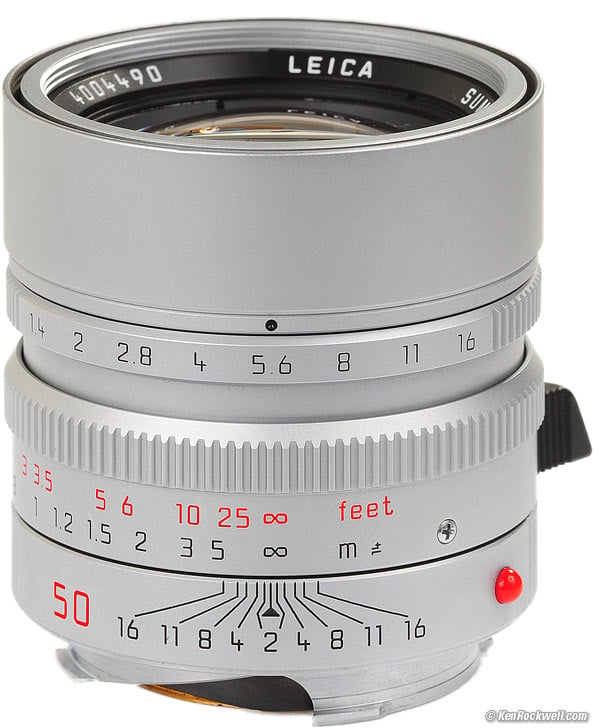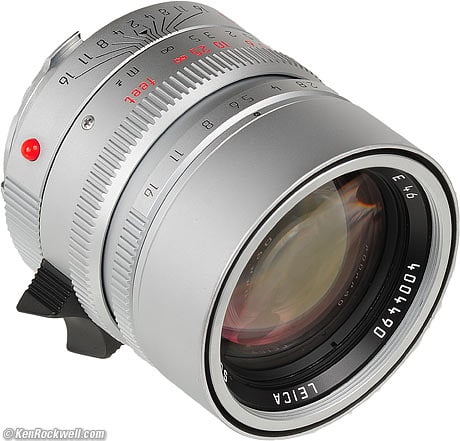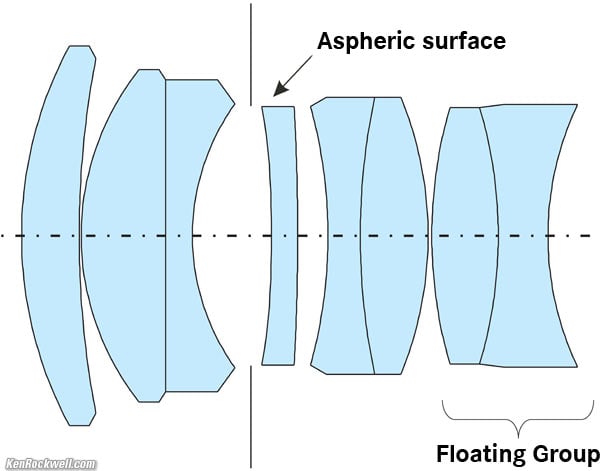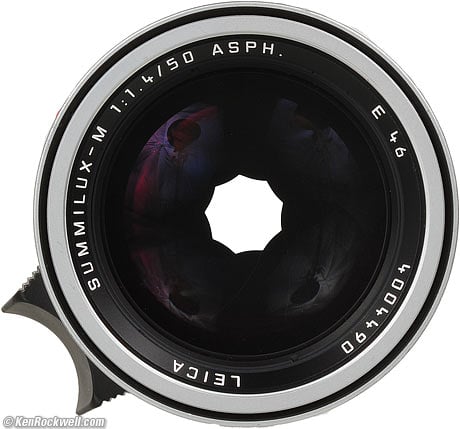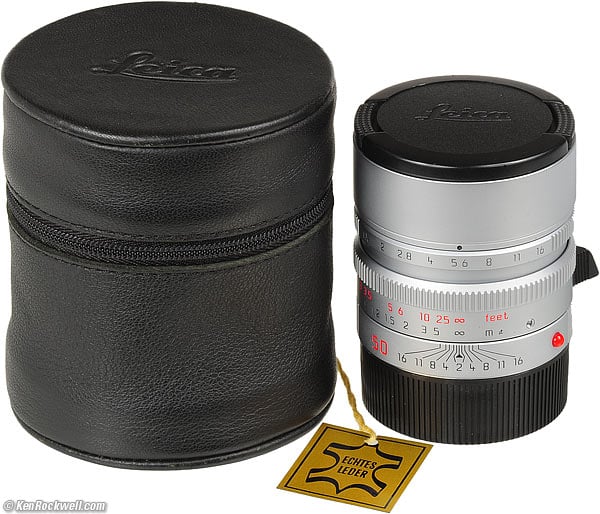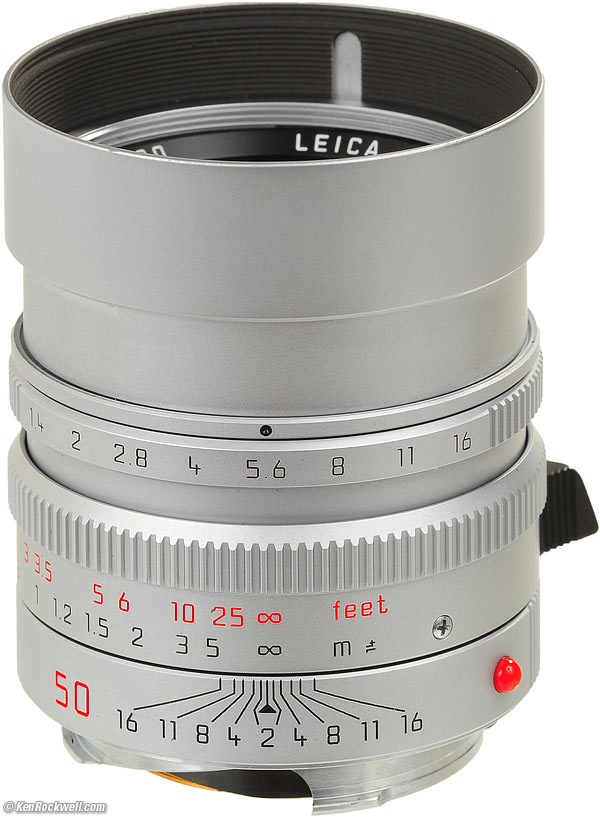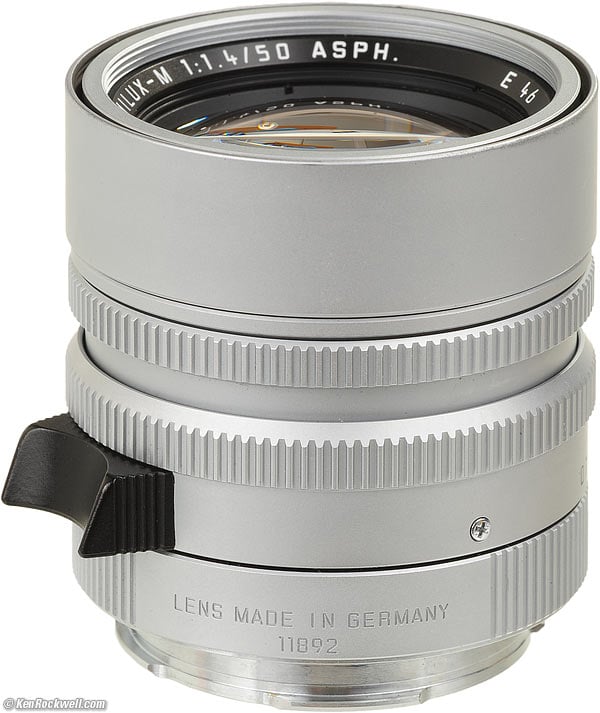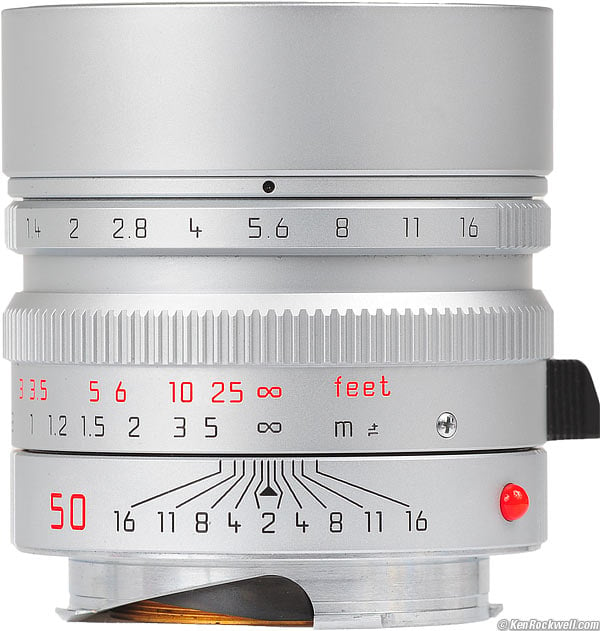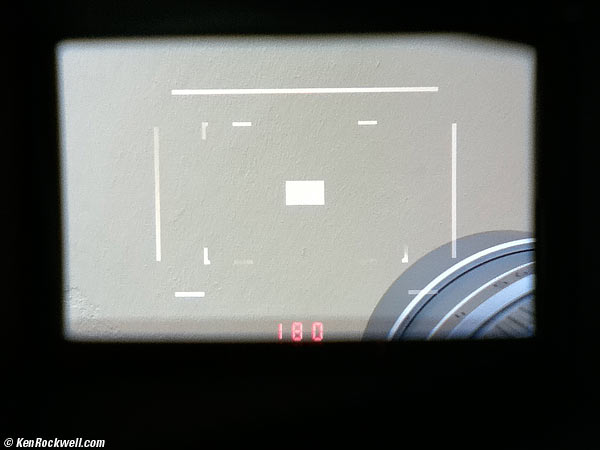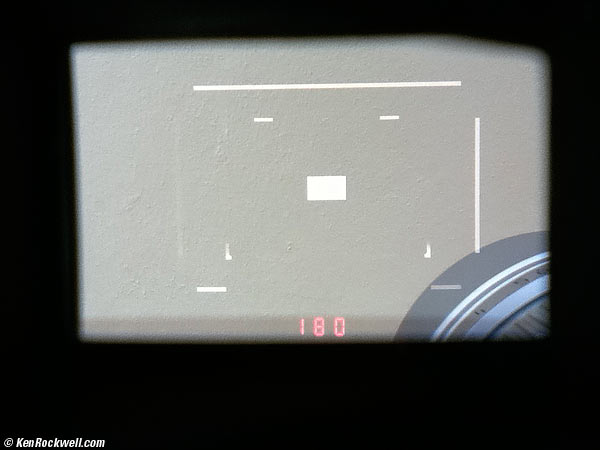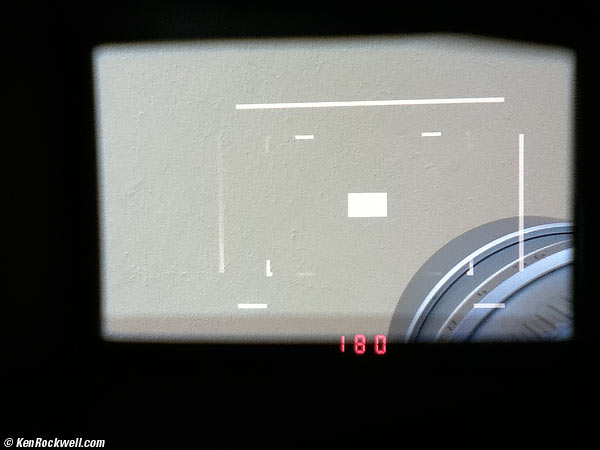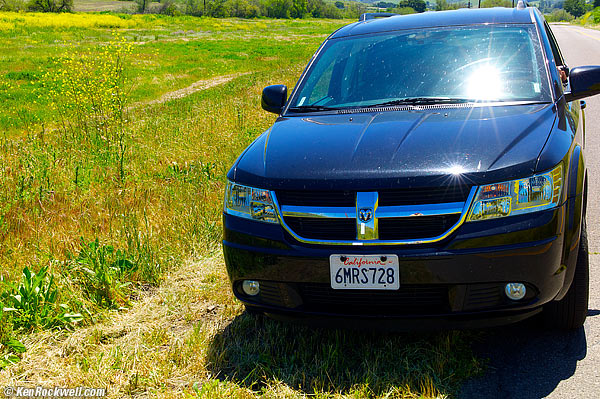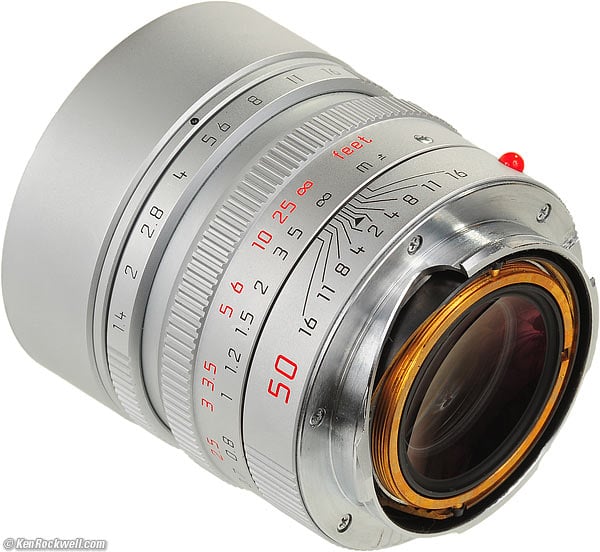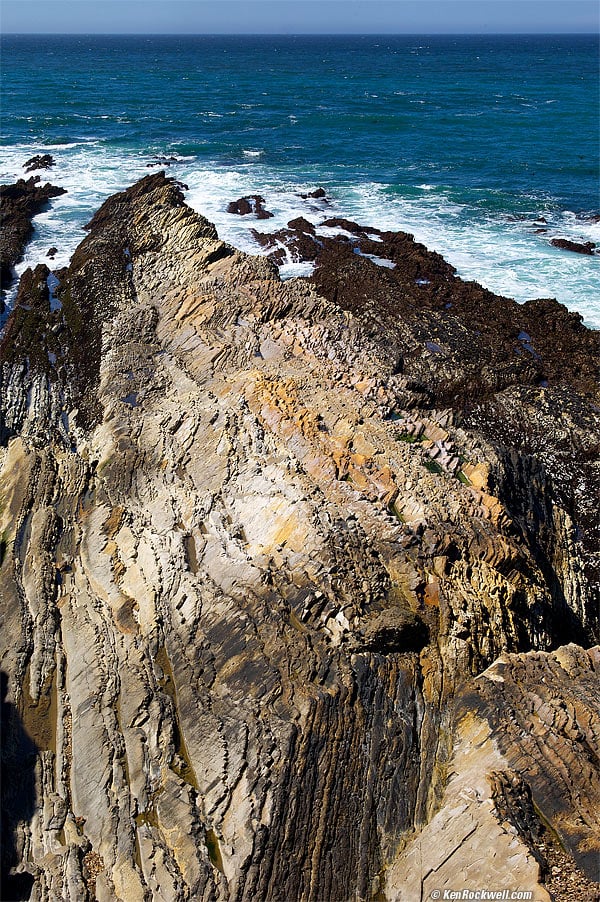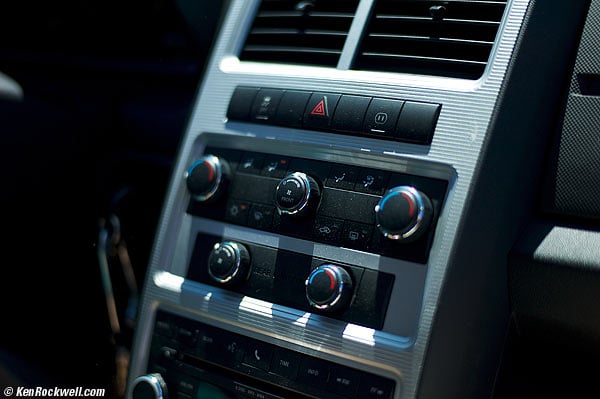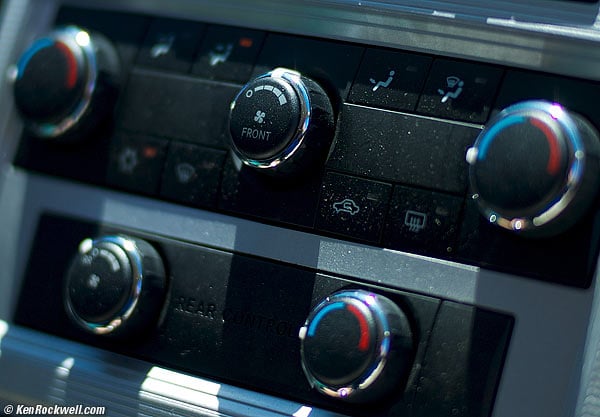Home Donate New Search Gallery Reviews How-To Books Links Workshops About Contact
LEICA 50mm f/1.4 ASPH
SUMMILUX-M
(2004-)
© 2011 KenRockwell.com. This page best with Corporate S regular and bold activated.
Intro Specs Performance Compared Recommendations
LEICA SUMMILUX-M 50mm f/1.4 ASPH, silver (46mm filters, 16.2 oz./460g; also comes in lightweight black,11.8 oz./335g; 2.5'/0.7m close focus, $4,800 in silver, $4,500 in black or about $3,000 used). Vergrößern.
This all-content, junk-free website's biggest source of support is when you use those or any of these links to approved sources when you get anything, regardless of the country in which you live. Buy only from the approved sources I use myself for the best prices, service, return policies and selection. Thanks for helping me help you! Ken.
April 2023 LEICA Reviews LEICA Lenses lesser-brand reviews
NEU: LEICA SUMMMILUX-M 50mm f/1.4 ASPH (Edition 2023), also in silver.
TTArtisan 50mm f/1.4 ASPH (2020-today)
Premium 50mm Lenses Compared 04 September 2014
See also:
LEICA SUMMILUX 50mm f/1.4 (1961-2004)
LEICA SUMMICRON-M 50mm f/2 (1979-today)
Sample Images:
Full-resolution © JPG from DNG.
California's Central Coast, April 2011.
Introduction top
Intro Specs Performance Compared Recommendations
|
Adorama pays top dollar for your used gear. I use these stores. I can't vouch for ads below. |
The LEICA SUMMILUX-M 50mm f/1.4 ASPH is a remarkable lens, being the world's only aspherical 50/1.4 with floating elements.
This SUMMILUX-M ASPH has the best bokeh of any LEICA lens, and it is LEICA's best 50mm f/1.4 ever, however it is still not as sharp as the LEICA SUMMICRON-M 50mm f/2. Nothing beats a SUMMICRON.
This LEICA SUMMILUX-M 50mm f/1.4 ASPH comes in lightweight black anodized aluminum, or solid chromed brass as shown here. This solid-brass silver version is very dense and heavy; even heavier than the larger black 90mm f/2.8 ELMARIT-M.
Compatibility top
This LEICA SUMMILUX-M 50mm f/1.4 ASPH works perfectly on every LEICA M camera, from 1954's LEICA M3 through today's newest LEICA M7, LEICA MP and LEICA M9.
LEICA SUMMILUX-M 50mm f/1.4 ASPH. Vergrößern.
Specifications top
Intro Specs Performance Recommendations
Name
Leica calls this the LEICA SUMMILUX-M 50mm f/1.4 ASPH.
The -M means it's for LEICA's M-Kameras.
ASPH means it has an aspherical element for higher optical performance.
Optics top
LEICA SUMMILUX-M 50mm f/1.4 ASPH diagram. Vergrößern.
8 elements in 5 groups.
One aspheric surface.
One floating group.
Multi-coated in green and dark blue/magenta.
The rear elements rotate as focused, while the front elements and diaphragm do not.
Diaphragm top
LEICA SUMMILUX-M 50mm f/1.4 ASPH at f/5.6. Vergrößern.
9 blades, curved inward at moderate apertures, and round only at f/16.
It stops down to f/16 with half-stop clicks.
Close Focus
0.68 meters (27" or 2.25 feet), actual measured.
0.7 meters (2.5 feet), marked.
Maximum Reproduction Ratio
1:11.3 (0.088x).
Filters
Common 46 x 0.75 mm (E46).
Size top
53.47 mm (2.105") maximum diameter by 52.60mm (2.071") extension from flange, actual measured, hood retracted and focused at infinity.
Weight top
16.240 oz. (460.4g), measured, silver.
LEICA specifies 11.8 oz. (335g) for the lightweight black version
Case and Caps top
LEICA SUMMILUX-M 50mm f/1.4 ASPH mit Case and Caps. Vergrößern.
LEICA includes a custom-padded genuine leather case with every lens. It has no straps and serves no purpose other than for protecting the SUMMILUX-M ASPH when it's thrown in the LEICAMAN's luggage.
The front cap is a snap-in plastic 46mm cap (14 231).
The rear cap is the standard 14 269 M rear cap.
Hood top
Hood Extended, LEICA SUMMILUX-M 50mm f/1.4 ASPH. Vergrößern.
The built-in hood slides in and out. It locks with a slight turn.
The hood is short and simple, and works well.
It's not perfect: it grabs a little while pulling-out, it has a bit of mechanical play as it pulls-out, and the rotating lock has no click-stop to keep it from undoing.
It has a large enough diameter to slide over any filter, including rotating polarizers and grads, and even the excellent larger-diameter 46mm filters for the Contax G system.
Part Numbers top
Silver lens: 11 892.
Black lens: 11 891.
Front 46mm cap: 14 231 (included).
Rear cap: 14 269 (included).
Bottom, LEICA SUMMILUX-M 50mm f/1.4 ASPH. Vergrößern.
Quality top
MADE IN GERMANY.
Price, USA top
April 2023
About $3,000 used if you know How to Win at eBay.
September 2014
April-November 2011
October 2009
$3,600 new.
Performance top
Intro Specs Performance Compared Recommendations
Overall Bokeh Distortion Ergonomics Falloff Finder Blockage
Flare and Ghosts Focus Lateral Color Mechanics
Sharpness Spherochromatism Sunstars
Overall performance top
The LEICA SUMMILUX-M ASPH 50/1.4 is LEICA's best 50mm f/1.4 yet. This lens has the best bokeh of any LEICA lens.
The 4-year-old sample I was loaned wasn't much sharper than the previous LEICA SUMMILUX 50mm f/1.4, and was much less sharp under exacting test conditions than the LEICA SUMMICRON-M 50mm f/2.
Bokeh performance top
Bokeh, the character of out of focus backgrounds, not simply how far out of focus they are, is extraordinary. Out of the dozens and dozens of different LEICA lenses I've evaluated, including the ballyhooed LEICA SUMMICRON-M 35mm f/2 (1979-1996), this 50mm f/1.4 ASPH has by far the best bokeh of any LEICA lens.
Bokeh is much, much better than the SUMMICRON-M 50mm f/2, and better than the LEICA SUMMILUX 50mm f/1.4 (click each to see its bokeh samples shot at the same time.)
Here are crops from extremely enlarged prints of about 35 x 52" (90 x 135cm), or the equivalent of looking at LEICA M9 images, shot as DNG and converted in Apple Aperture 3, at 100% on-screen.
In these examples, a vertically polarized phase lattice was set up at 3 meters (10 feet) on which the SUMMICRON-M ASPH was focused, while synthetic reference vegetation seen out of focus in the background was at 15 meters (50 feet).
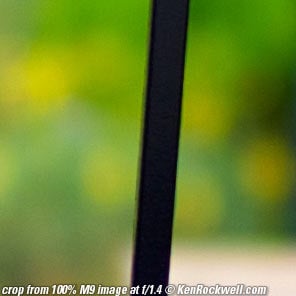 |
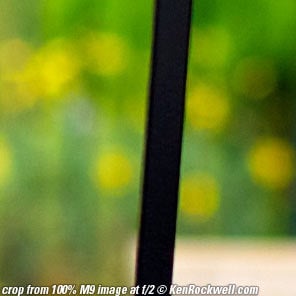 |
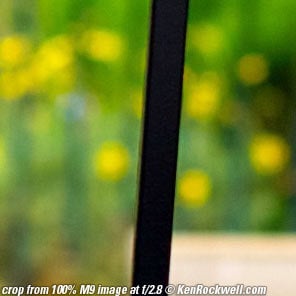 |
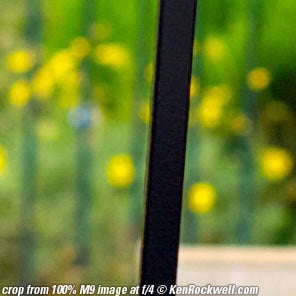 |
Distortion performance top
The LEICA SUMMILUX-M 50mm f/1.4 ASPH has no visible distortion.
This invisible distortion can be corrected for more critical use by plugging these figures into Photoshop's lens distortion filter. These aren't facts or specifications, they are the results of my research that requires hours of photography and calculations on the resulting data.
Correct with |
|
infinity |
-0.5 |
10' (3m) |
-0.5 |
© 2011 KenRockwell.com. All rights reserved.
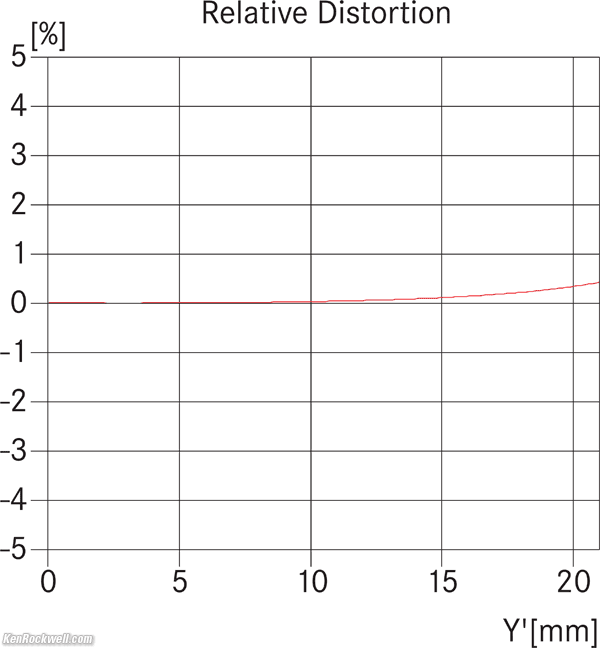
LEICA's claimed distortion.
Ergonomics performance top
LEICA SUMMILUX-M 50mm f/1.4 ASPH. Vergrößern.
The black lens is as expected, while this silver lens is a ton of solid brass. The silver version feels like a small cannonball.
This lens is much longer than you'd expect for a 50mm lens. It's almost as long as the 90mm f/2.8 ELMARIT-M. This solid-brass (silver) version is heavy, heavier than the black 90mm f/2.8 ELMARIT-M! The black version of this 50 1.4 is much lighter.
Ergonomics are good, but not perfect. The LEICA SUMMICRON-M 50mm f/2 is better.
Focus is stiffer than other LEICA lenses because there are not one, but two helicoids. The second set of helicoids is for the floating element group.
Instead of sliding smoothly, the focus has a very small amount of stiction which much be broken loose each time the focus ring is turned.
Focus is too fast for my taste; it requires concentration to set focus precisely. It is ideal for fast shooting, but sadly, the stiction greatly degrades the ability to focus well with one-finger.
Focus is both by black plastic finger tab, or by ridged metal ring.
With the focus tab dropped to the bottom, the focus is at 1.2m (4 feet).
Because of the fast focus gearing, the condensed depth-of-field scale is of little use. Oddly, at f/16, it shows a total hyperfocal range of 9.5 feet, not the usual 8 feet. I prefer an original (1959-1968) LEICA SUMMILUX 50mm f/1.4 for focus and use of the depth-of-field scale.
The aperture ring feels like the aperture ring of the silver LEICA SUMMICRON-M 90mm f/2: it's so heavy and smooth that it feels almost as if it has inertia as it flicks around, and the click stops are lighter than expected.
The engraving on the aperture ring is lighter than expected, so it can be more difficult to read in the dark. No worries, with LEICA lenses, apertures are easy to set by feel in the dark by counting clicks.
Falloff (darker corners) performance top
The LEICA 50mm f/1.4 SUMMILUX-M ASPH has visible falloff at f/1.4, even with a lens profile active. It's gone by f/2.8.
I've greatly emphasized it below by shooting a gray field and presenting it against another gray field.
LEICA 50mm f/1.4 SUMMILUX-M ASPH light Falloff on M9 at infinity: No lens profile:
© 2011 KenRockwell.com. All rights reserved.
With 50mm f/1.4 ASPH 11891/11892 profile:
© 2011 KenRockwell.com. All rights reserved.
|
Finder Blockage performance top
There is plenty of finder blockage. This is a fat, long lens with a simple tubular hood.
Finder blockage with this lens usually isn't an issue, but when you're composing with something important in that corner, it can be a deal-breaker.
The 43mm filter 1961-1991 LEICA SUMMILUX 50mm f/1.4 has much less blockage.
The LEICA SUMMICRON-M 50mm f/2 (1979-today) has little to no blockage, hood or no hood.
Finder blockage: M9 0.72x, focus at infinity, hood extended.
Finder blockage: M9 0.72x, focus at infinity, hood retracted.
Finder blockage: M9 0.72x, focus at 0.68 meters, hood extended.
Finder blockage: M9 0.72x, focus at 0.68 meters, hood retracted.
Flare and Ghosts performance top
Blinding reflection, LEICA M9. Vergrößern.
Flare and ghosts aren't a problem, and this photo was made with a LEICA 13 004 UVA filter over the lens!
The clear UVA (Portuguese for "grape") filter removed the grapes and vines that were along the side of this road in Santa Barbara county, California. UVA filters, completely unrelated to UV (ultra-violet) filters, were developed by LEITZ in the 1960s after Portuguese vintners near LEITZ' factory in Vila Nova de Famalicão (near Porto) asked the LEITZ scientists if they could develop a filter which would allow them to see past their vines to the ground below to aid in disease and pest prevention.
Focus performance top
Focus Accuracy
Focus accuracy is a personal issue between your sample of body and your sample of lens. No two samples match if you start looking too hard; this is a limitation of the mechanical technology.
This said, this particular sample focuses a little behind my intended subject at most distances — oops!
Focus Feel
Focus doesn't feel as good as other LEICA lenses because there are two helicoids operating at once to move the lens and the floating group.
The worst part is a bit of stiction, which means that a little more force is required to get it moving than is required to keep it moving. This makes precise adjustment a bit of a pain, along with the fact that focus is geared for speed rather than precision.
The 4-year old lens seen here was also a little sticky, so the weight of the lens made it a bit stiffer. If you lifted the lens a bit, it loosened up. There is no excuse for this; I have LEICA lenses more than 50 years old that focus better.
Lateral Color Fringes performance top
There are no lateral color fringes as shot on a LEICA M9, unless you're seeing spherochromatism, which is a completely different aberration.
Materials and Construction performance top
This SUMMILUX-M ASPH is made as well as anything.
This sample is solid brass; even the hood! The only plastic is the red plastic index ball and the black plastic focus tab.
As this is among LEICA's less-expensive lenses (well under $4,000 brand-new), one of the ways LEICA keeps the cost so low is by making the focus tab out of plastic, instead of metal as it used to be. Worse, the silver version uses a black tab; there is no silver tab for the silver lens as LEICA used to do on better lenses like the original and immortal LEICA SUMMICRON 35mm f/2 (8-element, 1958-1974). Likewise, LEICA removed the infinity lock from this lens.
In spite of my petty whining, this is the best-made 50mm f/1.4 made today by a very large margin. All markings are engraved and filled with paint.
Rear, LEICA SUMMILUX-M 50mm f/1.4 ASPH. Vergrößern.
Sharpness performance top
Proof-of-Performance: LEICA SUMMILUX-M 50mm f/1.4 ASPH. Full-resolution © JPG from DNG.
Warning 1: Image sharpness depends more on you than your lens.
Warning 2: Lens sharpness doesn't mean much to good photographers.
With these caveats, the SUMMILUX-M 50mm f/1.4 ASPH is sharper than the previous LEICA SUMMILUX 50mm f/1.4 (1961-2004), but not as sharp as the LEICA SUMMICRON-M 50mm f/2.
Specifically, the 50/1.4 ASPH is sharp in the center at every aperture, but softer and blurrier on the sides wide-open. This is measured of course by LEICA standards; most people will never see any actual softness in real photography, but to those of us who do this all day for a living, the sample I borrowed was much softer on the left side at f/1.4 at the test range.
This is a four-year-old loaner from LEICA. It was decentered (softer on one side than the other), and God only knows what abuse it may have suffered after years of being loaned to people who usually treat it with less care than a rental car. If I get to borrow another sample it might be better, or might not.
I tried another black sample from my friend Jim. It was exactly the same. If you want the best sharpness, get a SUMMICRON.
The SUMMILUX has always been a lens optimized for use with 35mm film in the very lowest light; not a lens optimized for ultimate sharpness. Maybe I borrowed a bad copy, but then again, you could get one, too. If sharpness is your ultimate concern, get the LEICA SUMMICRON-M 50mm f/2.
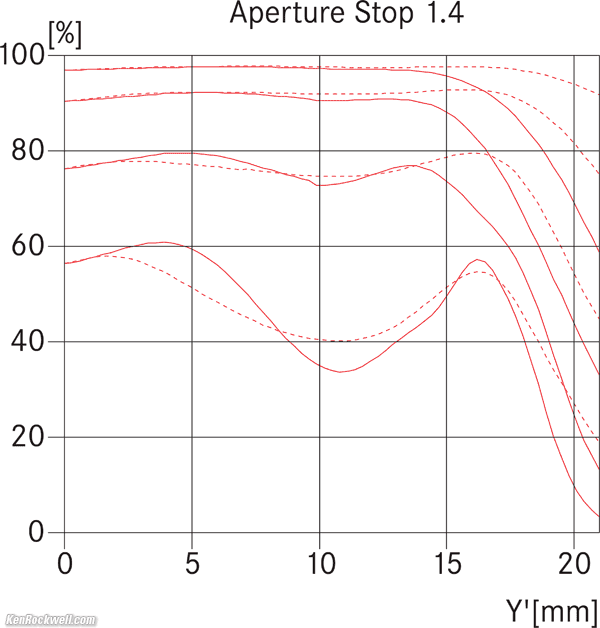
LEICA's claimed MTF at f/1.4; 5, 10, 20 und 40 cyc/mm.
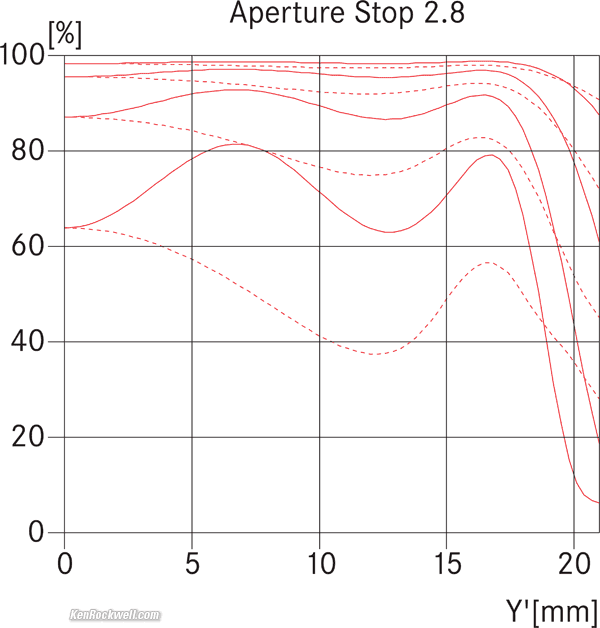
LEICA's claimed MTF at f/2.8; 5, 10, 20 und 40 cyc/mm.
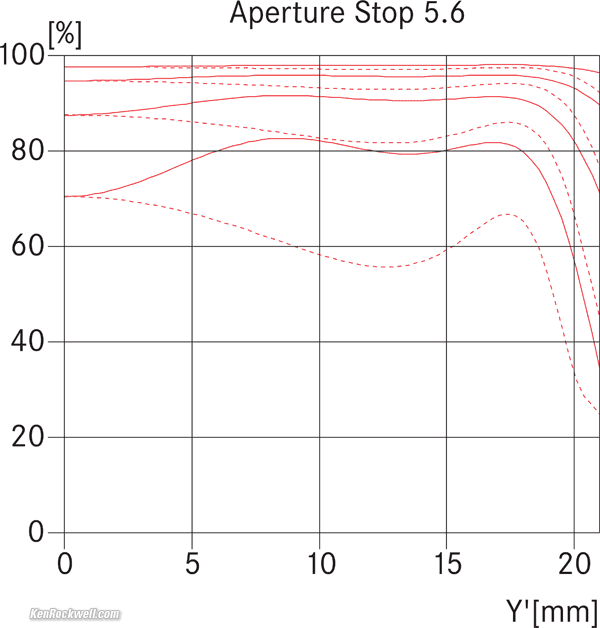
LEICA's claimed MTF at f/5.6; 5, 10, 20 und 40 cyc/mm.
Spherochromatism performance top
The LEICA SUMMILUX-M 50mm f/1.4 ASPH has nearly no spherochromatism.
Spherochromatism, mistakenly called "color bokeh" by laymen, is when out-of-focus highlights take on colored fringes, usually green and magenta.
In this 50mm SUMMILUX-M ASPH, slightly out-of-focus background highlights may take on slight green fringes, and slightly out-of-focus foreground highlights may take on slight magenta fringes.
You'll probably never see this unless you do something stupid, like shoot an overexposed, slightly out-of-focus, back-lit black railing or bare tree, in which case, you might see a tiny bit of purple or green. If this bothers you, get it in focus next time.
Spherochromatism, LEICA SUMMILUX-M 50mm f/1.4 ASPH at f/1.4.
Spherochromatism, closer crop. Vergrößern.
Sunstars performance top
18-point sunstars, about f/11. Vergrößern.
The SUMMILUX-M ASPH's 9-bladed diaphragm begets uniform 18-pointed sunstars on brilliant points of light.
Compared top
Intro Specs Performance Compared Recommendations
NEW: Premium 50mm Lenses Compared 04 September 2014
This 50/1.4 ASPH has superior bokeh and low distortion, but it's not that sharp when stacked up against the SUMMICRON in the lab, but certainly sharp enough.
| Dates | 2004- |
1961-2004 |
1979- |
2010- |
2004- |
2004- |
| Color | silver, later black |
silver or black |
black |
|||
| Filter | 46mm |
43mm, later 46mm |
39mm |
58mm |
46mm |
43mm |
| Length | 53mm |
46mm |
43mm |
57mm |
38mm |
43mm |
| Finder Blockage | ||||||
| Optics | 8/5 ASPH Floating |
7/5 |
6/4 |
7/6 |
6/4 |
6/4 |
| Diaphragm | 9 blades |
12 blades |
8 blades |
10 blades |
10 blades |
10 blades |
| Sunstars | 18 points |
12 points |
8 points |
10 points |
10 points |
10 points |
| Aperture ring clicks | half stops |
full, later half stops |
half stops |
half stops |
third stops |
third stops |
| f/min | f/16 |
f/16 |
f/16 |
f/16 |
f/16 |
f/22 |
| Close focus | 0.7m |
1m, later 0.7m |
0.7m |
1m |
0.9m |
0.7m |
| Focus Gearing | Fast |
Precise |
Fast |
Moderate |
Moderately fast |
Fast |
| Sharpness | good |
good |
extreme |
poor |
good |
excellent |
| Bokeh | Excellent |
fair |
fair |
fair |
Excellent |
fair-good |
| Distortion, 3m | -0.5 |
+0.4 |
+0.4 |
+1.0 |
+0.3 |
+1.5 |
| Weight* | 460g silver, 335g black |
275-380g |
198g, later 242g |
434g |
232g |
211g |
| Price, 4/2011 | $800-2,500(used) |
* Actual measured.
Recommendations top
Intro Specs Performance Compared Recommendations
For my style of photography, I prefer the sharper, smaller, lighter and ergonomically superior LEICA SUMMICRON-M 50mm f/2.
For the sorts of things shot by most LEICA photographers, like street scenes and environmental portraiture, the superior bokeh of this ASPH outweigh my whining about sharpness or blocked finders.
I hope another sample will perform better, but until I see one, I can't suggest you go out of your way waiting for this f/1.4 lens, especially for digital, where the difference between f/1.4 and f/2 is largely mitigated through higher ISOs.
For use in low-light, the 35mm SUMMILUX-M ASPH is what I shoot. I want the larger depth-of-field and greater resistance to camera shake offered by a 35mm as opposed to a 50mm f/1.4.
I'm looking forward to trying another sample of this ASPH, as I suspect it's got to be sharper than the sample I tried. Then again, I've used plenty of even more abused 50-year old LEICA lenses, and they work perfectly, so I don't know that 4 years in a loan pool would have affected this sample at all.
This ASPH f/1.4 lens has extraordinary bokeh. If you demand smooth out-of-focus backgrounds, this is the best lens I've ever seen from LEICA, ever. If you demand the absolutely sharpest possible lens, the SUMMICRON-M 50mm f/2 is superior.
The Carl Zeiss C Sonnar 1,5/50 ZM T* has bokeh almost as nice as this ASPH, for a fraction of the size and weight, and is usually in stock.
This is the LEICAMAN's 50mm lens. The LEICAMAN, like LEICA, isn't about photography; he's about the experience. This is the lens to have if you expect the best. If you're a photographer like me, I prefer the SUMMICRON-M 50mm f/2, which is sharper, smaller, lighter, doesn't block the viewfinder, and is easy to buy. This SUMMILUX-M ASPH excels only at élan, bokeh and sunstars.
How to find one top
I've been looking to buy one of these 50 ASPHs since 2008, and have never found one in stock.
They are extremely hard to find because they are extremely difficult for LEICA to make.
To get one, order one at this link to them at Adorama or at B&H Photo-Video, and wait. You also can try walking-in locally in Southern California at OC Camera.
If you're in a hurry, you can always find them at this link to them at eBay (see How to Win at eBay), but used ones will cost more than waiting for a new one.
Help me help you top
I support my growing family through this website, as crazy as it might seem.
The biggest help is when you use any of these links to approved sources when you get anything, regardless of the country in which you live. It costs you nothing, and is this site's, and thus my family's, biggest source of support. These places have the best prices and service, which is why I've used them since before this website existed. I recommend them all personally.
If you find this page as helpful as a book you might have had to buy or a workshop you may have had to take, feel free to help me continue helping everyone.
If you've gotten your gear through one of my links or helped otherwise, you're family. It's great people like you who allow me to keep adding to this site full-time. Thanks!
If you haven't helped yet, please do, and consider helping me with a gift of $5.00.
As this page is copyrighted and formally registered, it is unlawful to make copies, especially in the form of printouts for personal use. If you wish to make a printout for personal use, you are granted one-time permission only if you PayPal me $5.00 per printout or part thereof. Thank you!
Thanks for reading!
Mr. & Mrs. Ken Rockwell, Ryan and Katie.
Home Donate New Search Gallery Reviews How-To Books Links Workshops About Contact
